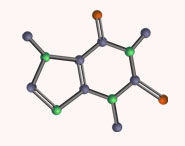


 علم الكيمياء
علم الكيمياء 
 الكيمياء التحليلية
الكيمياء التحليلية 
 الكيمياء الحياتية
الكيمياء الحياتية 
 الكيمياء العضوية
الكيمياء العضوية 
 الكيمياء الفيزيائية
الكيمياء الفيزيائية
 الكيمياء اللاعضوية
الكيمياء اللاعضوية 
 مواضيع اخرى في الكيمياء
مواضيع اخرى في الكيمياء
 الكيمياء الصناعية
الكيمياء الصناعية |
Read More
Date: 18-1-2016
Date: 9-10-2017
Date: 9-10-2017
|
DRUG: RECEPTOR INTERACTIONS
Although the Hansch reasoning does apply to the interaction of a drug with its receptor, many of the factors that are considered relate to the substance crossing barriers and entering different cellular phases. When we consider a drug interacting with a receptor or an enzyme system, there are a number of physico-chemical features that must be taken into account. A receptor or an enzyme system comprises a highly structured chiral environment dominated not just by the pockets created by the peptide chain but also by the varying nature of the amino acid side chains. The structure is also determined by the chemistry of any coenzyme that is also present and by the presence of water molecules that are hydrogen-bonded within the lattice and may need to be displaced as the drug binds. It is now possible to obtain X-ray structures of drugs bound within the active site of an enzyme and hence identify crucial interactions. Similar information can also be obtained from a nuclear magnetic resonance (NMR) spectroscopy.
Hydrogen bonding interactions with serine and tyrosine residues and ionic interactions with glutamate or aspartate residues are clearly important in binding. However, there are more subtle interactions involving hydrophobic parts of the drug fitting into hydrophobic pockets of a receptor or enzyme, which are created by the alkyl side chains of leucine and valine residues. Some of these pockets may not be significant when the natural substrate binds but may provide additional binding sites for a drug. There are also interactions between aromatic rings in the drug and the aromatic amino acids. The chemistry of interactions involved in the enzyme mechanism and the role of co-factors have to be considered. The interaction of a drug may be competitive with the natural substrate. In such a situation the drug will have many of the binding features of the natural substrate but lack an operational feature. In some circumstances it may be modelled on the transition state for the reaction or in other circumstances the drug may be a substrate for the enzyme but be converted into a product that then reacts with the enzyme, a ‘suicide’ inhibitor.
When the drug binds to its target, it may bring about a change in the conformation of the receptor or enzyme and thus exert its biological effect. The binding may be adjacent to the active site and the modification to the shape of the enzyme, an allosteric effect, may then affect the binding of the natural substrate. The target is a dynamic flexible system and the binding of the natural substrate may require or produce a change in shape. The allosteric binding of a drug may introduce a rigidity, which can alter this flexibility. The action of the benzodiazepines on the GABA receptor may be of this type.
When a drug is modelled on a hormone or a neurotransmitter, there is usually a need to develop selectivity so that the drug only interacts with specific receptors and not with all the receptors that are sensitive to a particular neurotransmitter. The natural neurotransmitters possess at least two distinct binding sites, for example, the catechol and the amino group of dopamine. These are separated by a flexible chain. Hence, it is possible to envisage these binding in different conformations in different receptors. Selectivity might then be achieved by imposing rigidity on the drug structure by inserting additional rings or substituents.
While the binding may involve hydrogen-bonding, receptors may be differentiated by the presence of additional hydrophobic pockets. Use may be made of this by introducing hydrophobic substituents into the drugs to develop selectivity.
This general discussion of the distribution and binding of drugs has highlighted the balance between physical properties that can lead to a successful drug. An interesting analysis of the consequences of this was made by Lipinski who profiled the physical properties of over 2000 successful drugs. After discounting polymers, peptides and phosphates,
Lipinski found that approximately 90% of the remaining compounds had a molecular weight less than 500, a calculated log P less than 5, a sum of hydrogen bond donors (OH and NH) less than 5 and a sum of hydrogen bond acceptors (as a sum of N and O) of less than 10. Analysis of the progress of drugs through the clinical phases has shown that there is a convergence towards these figures.



|
|
|
|
كل ما تود معرفته عن أهم فيتامين لسلامة الدماغ والأعصاب
|
|
|
|
|
|
|
ماذا سيحصل للأرض إذا تغير شكل نواتها؟
|
|
|
|
|
|
|
جامعة الكفيل تناقش تحضيراتها لإطلاق مؤتمرها العلمي الدولي السادس
|
|
|